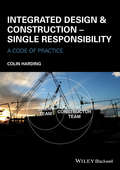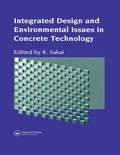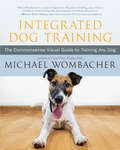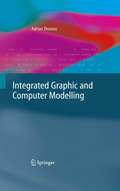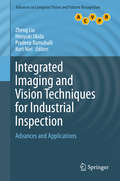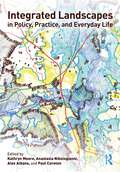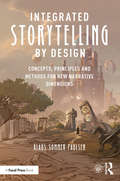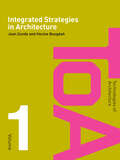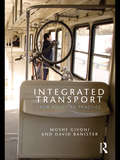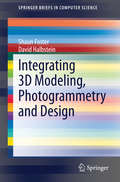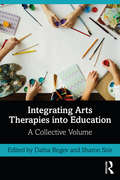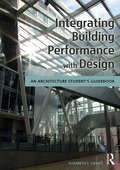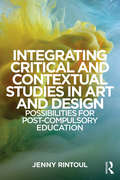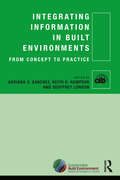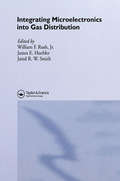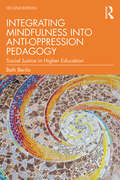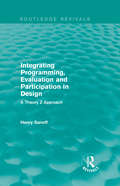- Table View
- List View
Integrated Design and Construction - Single Responsibility
by Chartered Institute of Building Colin HardingManufacturing and service industries have significantly improved their levels of productivity, quality, and profitability over the past 30 years, whereas in the construction industry similar levels of improvement have been impossible to achieve. Numerous reports have identified fragmentation of the industry's management structures and processes as the underlying cause of the waste and inefficiencies that keep costs high and margins low. Integrated Design and Construction is an integrated yet competitive form of procurement, design and project delivery based on the principle of purchasing any other high value warranted manufactured product. Such an approach would make the construction process more like other manufacturing industries, allowing contractors to make similar improvements to those already seen in other manufacturing industries. Designed for use by experienced construction professionals, familiar and proficient with traditional design and construction system best practice, this Code of Practice provides both client and constructor with the necessary information to adopt this approach to create well-designed and well-constructed products, fully meeting client needs.
Integrated Design and Delivery Solutions (Architectural Engineering and Design Management)
by Matthijs Prins Robert OwenIntegrated Design and Delivery Solutions (IDDS) represent a significant new research trajectory in the integration of architecture and construction through the rapid adoption of new processes. This book examines the ways in which collaboration and new methods of contracting and procurement enhance skills and improve processes in terms of lean and sustainable construction. Based on high quality research and practice-based examples that provide key insights into IDDS and its future potential, this book surveys the technologies that are being employed to create more sustainable buildings with added value for clients, stakeholders and society as whole.
Integrated Design and Environmental Issues in Concrete Technology
by K. SakaiThe two themes of integration of structural and durability design, and integration of concrete technologies in relation to global environmental issues are drawn together in this book. It presents the views of distinguished international researchers and engineers on these key topics as the 21st century approaches.
Integrated Dog Training: The Commonsense Visual Guide to Training Any Dog
by Michael WombacherA Comprehensive Dog Training Course in a Book, with Step-by-Step Photos and Guidance Designed for quick reference while working with your dog, this large-format guidebook features the full gamut of training exercises — each illustrated with photos and clear instructions. It offers a wealth of ways to approach various dogs and scenarios, whether you&’re training a puppy to sit or correcting training issues in a mature dog. Michael Wombacher, a trainer with decades of experience, knows all the competing dog training theories but also knows that in reality, it is a range of methods that gets dogs and their humans where they need to be. His Integrated Dog Training is a much-needed commonsense approach that avoids cookie-cutter dictates and recognizes the individuality of each dog. He includes straightforward discussions of situation-specific equipment, treats, and commands, as well as a variety of age- and environment-variable approaches. Easy-to-use, image-driven, and immediately applicable, this is a truly unique, invaluable resource that gets people and dogs in sync and happy lifelong.
Integrated Graphic and Computer Modelling
by Adrian ThomasComputer languages and computer graphics have become the primary modes of human-computer interaction. This book provides a basic introduction to "Real and Virtual Environment" computer modelling. Graphics models are used to illustrate both the way computer languages are processed and also used to create computer models of graphic displays. Computer languages have been bootstrapped from machine code, to high-level languages such as Java, to animation scripting languages. Integrating graphic and computer models takes this support for programming, design and simulation work, one step further, allowing interactive computer graphic displays to be used to construct computer models of both real and virtual environment systems. The Java language is used to implement basic algorithms for language translation, and to generate graphic displays. It is also used to simulate the behaviour of a computer system, to explore the way programming and design-simulation environments can be put together.
Integrated Imaging and Vision Techniques for Industrial Inspection: Advances and Applications (Advances in Computer Vision and Pattern Recognition)
by Zheng Liu Hiroyuki Ukida Pradeep Ramuhalli Kurt NielThis pioneering text/reference presents a detailed focus on the use of machine vision techniques in industrial inspection applications. An internationally renowned selection of experts provide insights on a range of inspection tasks, drawn from their cutting-edge work in academia and industry, covering practical issues of vision system integration for real-world applications. Topics and features: presents a comprehensive review of state-of-the-art hardware and software tools for machine vision, and the evolution of algorithms for industrial inspection; includes in-depth descriptions of advanced inspection methodologies and machine vision technologies for specific needs; discusses the latest developments and future trends in imaging and vision techniques for industrial inspection tasks; provides a focus on imaging and vision system integration, implementation, and optimization; describes the pitfalls and barriers to developing successful inspection systems for smooth and efficient manufacturing process.
Integrated Landscapes in Policy, Practice and Everyday Life
by Kathryn Moore Paul Cureton Anastasia Nikologianni Alex AlbansExploring the ways in which an integrated landscape vision can help deliver regional, national, and international agendas, this book investigates how a new idea of landscape can reimagine governance, policy, economics, culture, identity, health, transport, and development priorities by connecting in a more powerful and meaningful way with local aspirations and demands. Developed in fieldwork undertaken over the last decade, the capacity of a landscape-led approach to deal with problems such as rapid urbanisation, water and food security, climate change, air pollution, and health is both timely and topical. Divided into three main sections, it includes illustrated case studies from the UK, Europe, East Asia, South Asia, and more. As part of a strategy to capture, build, and disseminate expertise in this approach, the book aims to develop an interdisciplinary body of work that will appeal to academics and professionals, by bringing together a number of contributors who are operating at the cutting edge of landscape-led large-scale transformation. This book is essential for practitioners and academics of landscape architecture, as well as students in the architecture and design fields.
Integrated Science: Science Without Borders (Integrated Science #1)
by Nima RezaeiThe “INTEGRATED SCIENCE: Science without Borders” is the first volume of INTEGRATED SCIENCE Book series, aims to publish the results of the most update ideas and reviews in transdisciplinarity fields, to highlight integration of different disciplines, including formal sciences, physical-chemical sciences and engineering, biological sciences, medical sciences, and social sciences. This is especially focused on the research involving the integration of two of more academic fields offering an innovative view, which is one of the main focuses of Universal Scientific Education and Research Network (USERN); science without borders. The whole world is suffering from complex problems; these are actually borderless problems; so, borderless solution could be the solution for such complex problems. Transdisciplinarity, as a domain that researchers work jointly, using shared conceptual framework drawing together disciplinary-specific theories, concepts and approaches to address common problem. Lack of confidence, lack of expertise, complexities of healthcare, the confusing nature of healthcare environments and lack of organization and standardization became obstacles to successful communication. Consequently, the book is to provide an overview of the basic elements of transdisciplinary studies and integrated science. The unique aspect of this book, privileging it from other books, is covering all aspects of science as a true one nature.
Integrated Storytelling by Design: Concepts, Principles and Methods for New Narrative Dimensions
by Klaus Sommer PaulsenThis pioneering work equips you with the skills needed to create and design powerful stories and concepts for interactive, digital, multi-platform storytelling and experience design that will take audience engagement to the next level. Klaus Sommer Paulsen presents a bold new vision of what storytelling can become if it is reinvented as an audience-centric design method. His practices unlock new ways of combining story with experience for a variety of existing, new and upcoming platforms. Merging theory and practice, storytelling and design principles, this innovative toolkit instructs the next generation of creators on how to successfully balance narratives, design and digital innovation to develop strategies and concepts that both apply and transcend current technology. Packed with theory and exercises intended to unlock new narrative dimensions, Integrated Storytelling by Design is a must-read for creative professionals looking to shape the future of themed, branded and immersive experiences.
Integrated Strategies in Architecture (Technologies of Architecture)
by Joan Zunde Hocine BougdahThis key text presents students with a holistic view of the building design process, bridging the gap between the theory and practice of constructing and assembling buildings. Integrated Strategies in Architecture encourages and enables students to gain a sound understanding of the purpose of buildings, the specialisms that contribute and the available technology. Zunde and Bougdah thoroughly introduce and expose the concepts and technologies that underlie the design process, setting current design in context as part of an evolutionary process, exemplified through historic and contemporary models, and emphasizing the importance of applying a broad variety of technologies in the creation of successful buildings. Topics covered include: space planning, colour theory, communication, management, aesthetics, structures and environmental control. This essential text will greatly assist students of architecture and its technology, construction management and building surveying as well as practitioners as they strive to build better buildings.
Integrated Sustainable Design of Buildings
by Paul ApplebyIntegrated Sustainable Design of Buildings aims to provide a guide to members of design and masterplanning teams on how to deliver sustainable development and buildings cost effectively, meeting current and emerging UK and international statutory and planning requirements. Using a series of case histories and examples from the author's ten years of providing sustainability advisory services the book sets out a clear and understandable strategy that deals with all aspects of sustainable design and construction and the implications for delivery, costs, saleability and long term operation. The extensive scope includes all aspects of environmental, social and economic sustainability, including strategies to reduce carbon emissions and the impact of climate change. Integrated Sustainable Design of Buildings appeared in the Cambridge Top 40 Sustainability Books of 2010.
Integrated Transport: From Policy to Practice
by David Banister Moshe GivoniTravel is an essential part of everyday life and today most journeys are multimodal. It is the total travel experience that counts and integrated transport must reduce the inconvenience of transfers between modes. Most research and many publications on transport policy advocate sustainable transport, but the priority given to integration has been negligible. Yet integration is one of the most important means to advance sustainable transport and sustainability more generally. While integrated transport systems are seen to be an ideal, there is a failure to make the transition from policy to practice. The authors argue that the achievement of sustainable transport is still a dream, as an integrated transport policy is a prerequisite for a sustainable transport system. It is only when the two concepts of sustainability and integration operate in the same direction and in a positive way that real progress can be made. In this book, transportation experts from across the world have addressed the questions about what is integration, why is it so important and why is it so hard to achieve? The book provides an in-depth analysis of these issues and it aims to provide a better understanding of the subject, about what should be strived for, about what is realistic to expect, and about how to move forward towards a more integrated provision of transport infrastructure, services and management.
Integrated Urban Models Volume 1 (RLE: The City): New Research And Applications Of Optimization And Dynamics
by S. H. PutmanThis book was first published in 1983.
Integrated Urban Models Volume 2: New Research and Applications of Optimization and Dynamics (Routledge Revivals)
by Stephen H. PutmanFollowing on from Integrated Models Volume 1: Policy Analysis of Transportation and Lane Use (Routledge Library Editions, 2006), this book bridges the gap between the scholars and the practitioners of transportation and land-use modelling. First published in 1991, chapters discuss model-calibration and model-solution problems, describe a series of numerical and policy analyses, and propose potential directions for location and land-use research. This reissue will be of particular value to undergraduate and postgraduate geography students with an interest in integrated urban modelling; in particular, the research conducted in the field over the past two decades.
Integrated Water Resource Planning: Achieving Sustainable Outcomes
by Claudia Baldwin Mark HamsteadIntegrated Water Resource Planning provides practical, evidence-based guidance on water resource planning. In a time of heightened awareness of ecosystem needs, climate change, and increasing and conflicting demands on resources, water professionals and decision-makers around the world are on a steep learning curve. This book presents an international examination of water reform experiences, and provides lessons in how to manage environmental uncertainties, long term management, and increase in demand. It breaks the process down into a series of common steps, applies program logic and evaluation theory, and discusses best practices in assessment, decision making and community engagement. Importantly it recognises the large variation in available knowledge and capacity, risk and scale, and discusses a range of approaches that can be used for different circumstances. The book will fill in the gaps for professionals in interdisciplinary teams including sociologists, hydrologists, engineers, ecologists, and community consultation specialists, by providing a basic grounding in areas outside their usual expertise, and will provide ammunition to community stakeholders in their quest to ensure that water planning outcomes are justified and justifiable. Case studies provide an understanding of the context, practical tools and implementation techniques for achieving sustainable outcomes, and the multi-disciplinary approach and insights offered in this book will be transposable and instructive for water professionals worldwide.
Integrating 3D Modeling, Photogrammetry and Design
by Shaun Foster David HalbsteinThis book looks at the convergent nature of technology and its relationship to the field of photogrammetry and 3D design. This is a facet of a broader discussion of the nature of technology itself and the relationship of technology to art, as well as an examination of the educational process. In the field of technology-influenced design-based education it is natural to push for advanced technology, yet within a larger institution the constraints of budget and adherence to tradition must be accepted. These opposing forces create a natural balance; in some cases constraints lead to greater creativity than freedom ever can - but in other cases the opposite is true. This work offers insights into ways to integrate new technologies into the field of design, and from a broader standpoint it also looks ahead, raising further questions and looking to the near future as to what additional technologies might cause further disruptions to 3D design as well as wonderful creative opportunities.
Integrating Arts Therapies into Education: A Collective Volume
by Dafna Regev and Sharon SnirThis book offers a variety of effective, concrete ways to better assimilate arts therapies in the educational system. Featuring leading art therapists and the models they have honed as a result of their arts experience in education, Integrating Arts Therapies into Education discusses systemic issues and challenges related to work in the education system such as confidentiality, multidisciplinary teamwork with educators and contact with parents. Divided into two parts, the first discusses systemic issues related to work in the education system, and the second presents a series of dedicated models that can be implemented in the education system. Each chapter consists of a theoretical background, a description of the working model, a clinical example or case study and a summary. Creative arts and expressive therapy practitioners will find this guide filled with the most effective ways to approach and deliver arts therapies in a school setting.
Integrating Building Performance with Design: An Architecture Student’s Guidebook
by Elizabeth J. GrantIntegrating Building Performance with Design shows you the importance of designing for building performance early in your architectural design process. The book offers you simple tools and exercises, along with examples of built professional work and successful student projects illustrated by more than 100 full color images to help you with your work. Topics include site, solar orientation, thermal comfort, building enclosure, daylighting, passive heating and cooling, active heating and cooling, indoor air quality, stormwater, and rainwater harvesting.?
Integrating Care: The architecture of the comprehensive health centre
by Justin De SyllasThis book provides a timely review of the contemporary interpretation of the ‘comprehensive health centre’, a building type that was originally advocated by health reformers in the UK in the first half of the twentieth century. The book discusses the development of this idea, the failure under the NHS to apply the idea in practice in the second half of the century and the recent emergence, in all four regions of the UK, of comprehensive health centres providing a wide range of health and social services, often linked to other community facilities. A review of the latest developments in comprehensive health centre design forms the core of the book in the form of detailed case studies of ten exemplary recent projects. Generously illustrated in full colour the case studies include plans, diagrams, photographs and analytical text, providing the reader with detailed information about a range of design approaches. Following devolution, NHS health policies in England, Scotland, Northern Ireland and Wales have begun to diverge and the role of the comprehensive health centre in the current health service of each country is assessed. Aimed at professionals, healthcare facilities providers and policy makers, the book also considers the opportunities for and obstacles facing the further development of the comprehensive health centre as an integral part of the infrastructure of the NHS in the future.
Integrating Critical and Contextual Studies in Art and Design: Possibilities For Post-Compulsory Education
by Jenny RintoulIntegrating Critical and Contextual Studies in Art and Designexamines the relationship between two aspects of art education that appear at times inseparable or even indistinguishable, and at others isolated and in conflict: Critical and Contextual Studies (CCS) and studio practice. Underpinned by international contexts, this book is rooted in British art and design education and draws upon contemporary case studies of teaching and learning in post-compulsory settings in order to analyse and illustrate identities and practices of CCS and its integration. The chapters in this book are divided into three sections that build on one another: 'Discourse and debate'; 'Models, types and tensions'; and 'Proposals and recommendations'. Key issues include: knowledge hierarchies and subject histories and identities; constructions of 'theory' and the symbiotic relationship between theory and practice; models and practices of CCS within current post-compulsory British art and design education; the reification of ubiquitous terms in the fields of art and design and of education: intuition and integration; approaches to curriculum integration, including design and management; and suggestions for integrating CCS in art and design courses, including implications for pedagogy and assessment. Integrating Critical and Contextual Studies in Art and Designoffers a comprehensive analysis of the current drive towards integration within art education, and elucidates what we understand by the theory and practice of integration. It explores the history, theory, teaching and student experience of CCS, and will be of interest to lecturers, teachers and pedagogues involved in art and design as well as researchers and students of art education.
Integrating Information in Built Environments (Cib Ser.)
by Adriana X Sanchez Keith Hampson Geoffrey LondonIn an increasingly globalised built environment industry, achieving higher levels of integration across organisational and software boundaries can lead to improved economic, social and environmental outcomes. This book is the direct result of a collaborative global network of industry and academic researchers spread across nine countries as part of CIB’s (International Council for Research and Innovation in Building and Construction) Task Group 90 (TG90) Information Integration in Construction (IICON). The book provides a broad view of some of the opportunities and challenges brought by integrating information across organisational and system boundaries in the built environment industry. Chapters cover a large range of topics and are separated into three sections: resources, processes and added value. They provide a much-needed international perspective on a current global evolution in the industry and present leading original research and valuable lessons for researchers, industry practitioners, government clients and policy makers across the industry. Key features include: a broad range of topics that are not covered elsewhere in the literature; contributions from a diverse group of industry research leaders from across the globe; exemplar case studies providing real-world examples of where information integration has been a key factor for success or lack thereof has been at the root cause of failure; an analysis of future priority areas for research and development investment as well as their strategic implications for public and private decision-makers; the book will deliver innovation in best practice methodology for information sharing across disciplines and between the design, construction and asset management sectors.
Integrating Innovation in Architecture: Design, Methods and Technology for Progressive Practice and Research (AD Smart)
by Ajla AksamijaToday’s design professionals are faced with challenges on all fronts. They need not only to keep in step with rapid technological changes and the current revolution in design and construction processes, but to lead the industry. This means actively seeking to innovate through design research, raising the bar in building performance and adopting advanced technologies in their practice. In a constant drive to improve design processes and services, how is it possible to implement innovations? And, moreover, to assimilate them in such a way that design, methods and technologies remain fully integrated?Focusing on innovations in architecture, this book covers new materials and design methods, advances in computational design practices, innovations in building technologies and construction techniques, and the integration of research with design. Moreover, it discusses strategies for integrating innovation into design practices, risks and economic impacts. Through numerous case studies, it illustrates how innovations have been implemented on actual architectural projects, and how design and technical innovations are used to improve building performance, as well as design practices in cutting-edge architectural and engineering firms.Projects of all scales and building types are discussed in the book, ranging from small-scale installations, academic and commercial buildings to large-scale mixed-use, healthcare, civic, academic, scientific research and sports facilities. Work from design firms around the globe and of various scales is discussed in the book, including for example Asymptote Architecture, cepezed, CO Architects, Consarc Architects, FAAB Architektura, Gerber Architekten, HOK, IDOM-ACXT, MAD Architects, Morphosis Architects, SDA | Synthesis Design + Architecture, Studiotrope, Perkins+Will, Richter Dahl Rocha & Associés, Snøhetta, Rob Ley Studio, Trahan Architects, UNStudio and Zaha Hadid Architects, among many others.
Integrating Microelectronics into Gas Distribution
by William F. Rush James E. Huebler Jared R. W. SmithThis book considers technical, economic, and policy aspects of application of microelectronics to gas distribution problems. It is based on the first and second IGT symposia on microelectronics in the gas industry to disseminate information on rapidly evolving topics of gas distribution automation.
Integrating Mindfulness into Anti-Oppression Pedagogy: Social Justice in Higher Education
by Beth BerilaDrawing from mindfulness education and social justice teaching, this book explores an effective Anti-Oppression pedagogy for university and college classrooms. Authentic classroom discussions about oppression and diversity can be difficult; a mindful approach allows students to explore their experiences with compassion and to engage in critical inquiry to confront their deeply held beliefs and value systems. This engaging book is full of practical tips for deepening learning, addressing challenging situations, and providing mindfulness practices in anti-oppression classrooms. In this fully revised edition, Dr. Berila positions discussion in the current context and expands exploration of power and implicit bias, transformative learning, and trauma. Integrating Mindfulness into Anti-Oppression Pedagogy is for all higher education professionals interested in and teaching Social Justice pedagogy that empowers and engages students in the complex unlearning of oppression.
Integrating Programming, Evaluation and Participation in Design: A Theory Z Approach (Routledge Revivals Ser.)
by Henry SanoffFirst published in 1992, this book is about making connections that may lead towards a new professionalism, since the past several decades have given rise mainly to new kinds of specialists in the areas of programming, evaluation, and participation. The implications for such integration are far reaching, with profound future effects on the physical environment, the design professions, and the education of designers. The book is split into four sections dealing with facility programming, several forms of evaluation, participatory design, and the application of Theory Z principles. This book will be of interest to students of architecture and design.
